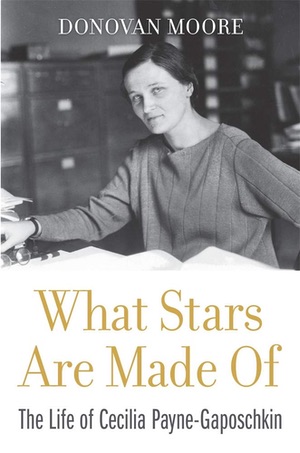Review: What Stars Are Made Ofby Jeff Foust
|
| Yet the astronomer who discovered just how abundant hydrogen is in the universe is largely unknown outside of the field, and often forgotten within it: Cecelia Payne. |
What Stars Are Made Of by journalist Donovan Moore seeks to undo that oversight and shed light on the life and career of Cecelia Payne (Cecelia Payne-Gaposchkin after her marriage to Russian astronomer Sergei Gaposchkin), including the many obstacles she had to overcome as a woman in a field dominated by men. The result is an engaging, enlightening biography about a key figure in astrophysics in the 20th century.
Growing up in England at the dawn of the 20th century, Payne was long interested in science and nature. She persevered despite schools that dissuaded girls from science; she got kicked out of one London school when her desire to study science and advanced mathematics became too much for administrators, but found another more willing to accommodate her interests. She then secured a scholarship to attend Cambridge University, with plans to study botany.
Payne, though, was also interested in physics, attended a lecture by Sir Arthur Eddington, who discussed his eclipse expedition that confirmed Einstein’s predictions about how gravity warped spacetime. That lecture, she later recalled, was like a “thunderclap,” and by the end of her first year decided to pursue physics. She was interested in astronomy in particular, but seeing few career options for her in England upon graduation, secured funding to go to America, to Harvard College Observatory. The observatory’s new director, Harlow Shapley, was working to more closely integrate the observatory into the university, and Payne became his first graduate student.
Payne arrived at Harvard with a topic she wanted to pursue: confirming theoretical work by an Indian physicist, Meghnad Saha, that sought to link the classification of stars developed at Harvard, based on their spectra, to their physical characteristics. She was, at the time, at the vanguard of the emerging field of astrophysics, combining astronomical observations with physics, applying knowledge of the structure of the atom to massive, distant starts..
At Harvard she had access to an extensive collection of stellar spectra, analyzing them in detail for that work, including the composition of the stars. It went well, except for two problems. One was the helium spectral signature seen in the stars could only be explained if its abundance was a thousand times greater than seen on Earth. Worse, the intensity of the hydrogen spectral lines implied it was a million times more abundant.
Those results became a sticking point when she wrote her thesis. She found no errors in the analysis that showed the abundance of hydrogen and helium, but it ran afoul of the consensus position in astronomy of the era, threatening her ability to get her doctorate and derailing Shapley’s plans to create an astronomy department at Harvard. Henry Norris Russell, who reviewed her thesis, ultimately approved it when she included a passage about the abundances that stated that they “are regarded as spurious.”
| As astronomer and historian Owen Gingerich noted in the book, “it is a person who persuades his colleagues of a new result who gets the credit.” |
Payne spent the rest of her career at Harvard, eventually becoming its first woman faculty member. She met Gaposchkin at an astronomy conference in Germany as he was trying to flee the country, fearing he would be jailed under the new Nazi regime. She helped him out of the country and to America, and months later they married. She passed away in 1979.
And, ultimately, she was proven right: within several years Russell himself determined that the Sun was mostly hydrogen and helium, and thus other stars were as well. Russell got the credit at the time for that “discovery” even those Payne had demonstrated it in her earlier thesis. As astronomer and historian Owen Gingerich noted in the book, “it is a person who persuades his colleagues of a new result who gets the credit.”
History, fortunately, has revised that assessment, and Payne-Gaposchkin is now widely seen as the astronomer who discovered the stars are mostly hydrogen and helium. She still, though, doesn’t have the recognition today of her contemporaries. (She was featured in an episode of the new Cosmos series in 2014, titled “Sisters of the Sun.”) What Stars Are Made Of isn’t perfect: it dwells a lot on her childhood, and speeds through much of her Harvard career after her landmark thesis. Nonetheless, it’s an important work in helping bring to light an important, but often overlooked, person in 20th century astrophysics.
Note: we are temporarily moderating all comments submitted to deal with a surge in spam.
